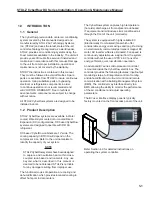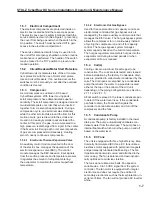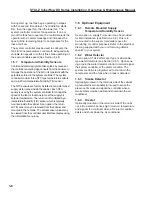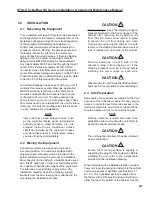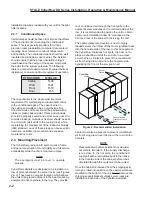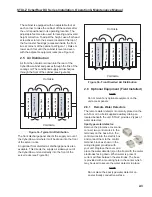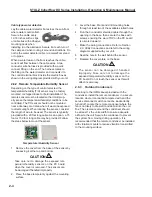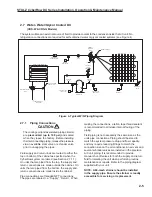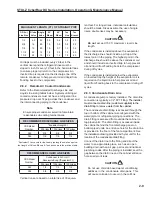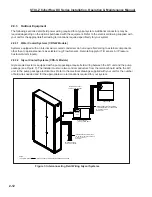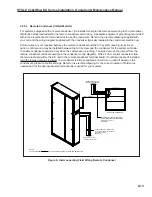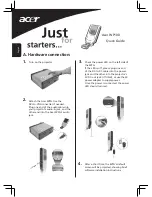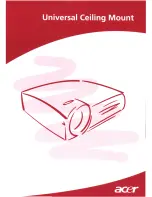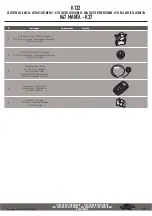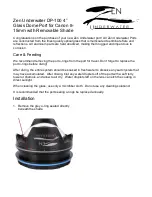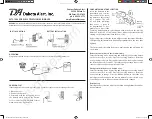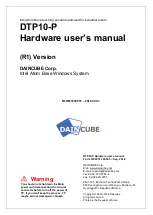
STULZ CyberRow DX Series Installation, Operation & Maintenance Manual
2-2
installation drawing provided with your unit for the pilot
hole locations.
2.3.1 Conditioned Space
Certain steps should be taken to minimize the effects
of the environment surrounding the conditioned
space. This is especially important for critical/
precision room preparation (computer data centers)
requiring close tolerance control of temperature
and humidity. The conditioned space should be well
insulated and include a vapor barrier. The installer
should ensure that the proper insulation rating is
used based on the design of the space, which was
the basis for the system selected. The following
table is a recommended minimum R-value (thermal
resistance) to ensure optimum equipment operation.
STRUCTURE R-VALUE
Ceiling
R-38
Wall
R-21
Floor
R-19
Door
R-5
The vapor barrier is the single most important
requirement for maintaining environmental control
in the conditioned space. The vapor barrier in
the ceiling and walls can be a polyethylene fi lm.
Concrete walls and fl oors should be painted with a
rubber or plastic based paint. Doors and windows
should be properly sealed and a door sweep used to
minimize leakage. Outside or fresh air should be kept
to a minimum (as it adds to the cooling load), while
maintaining the requirement of the Indoor Air Quality
(IAQ) standard. Lack of these steps can cause erratic
operation, unstable room control and excessive
maintenance costs.
2.4 Mounting/Placement
The
CyberRow
precision A/C system uses a frame
and panel construction for unit rigidity and full service
accessibility while the unit is mounted in place.
NOTE
The equipment must be level to operate
properly.
CyberRow cabinets are designed to be installed in a
row of servers between the server racks (see Figures
2 & 3). They have a compact footprint, which allows
the units to be placed adjacent to the heat producing
equipment racks anywhere in the row. They provide
cool, conditioned air through the front grille to the
adjacent server modules on the cold aisle side of the
row. It is recommended to position the unit to obtain
optimum air circulation. Allow 36” clearance in the
front and rear of the cabinet for servicing the unit.
The optimal placement location is next to highly
loaded servers that throw off the most signifi cant heat
into the hot aisle side of the row. In this arrangement,
the CyberRow minimizes hot spots. It is best not to
place a CyberRow unit at the end of a row unless
an air barrier is in place to prevent the conditioned
air from being drawn around to the hot aisle side,
bypassing the front of the servers. An air
Figure 2- Recommended Installation
Server
Racks
CyberRow
Units
36”
36”
Recommended
Clearance Front &
Rear
barrier must also be present to prevent conditioned
air from being drawn over the top of the row into the
hot aisle.
NOTE
Placement of air barriers between the cold aisle/
hot aisle is important. If the supply discharge
is too close to the hot aisle, the conditioned
supply air will be recirculated back to the intake
in the hot aisle side of the cabinet before it has
circulated through the equipment to be cooled.
Once the cabinet is removed from the shipping skid,
it may be rolled into position on the casters which are
mounted to the bottom of the unit. Do not remove the
shipping support brackets unless server racks are
installed on each side of the CyberRow cabinet.
Содержание CyberRow DX CRS-042-G
Страница 94: ......





